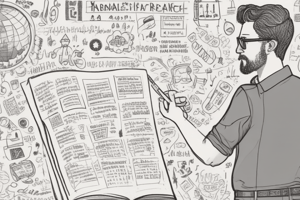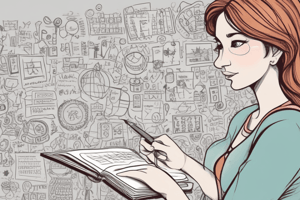Podcast
Questions and Answers
Quelle méthode de prise de notes est considérée comme plus mémorable selon la recherche mentionnée dans le texte?
Quelle méthode de prise de notes est considérée comme plus mémorable selon la recherche mentionnée dans le texte?
- La prise de notes textuelle
- L'utilisation d'icônes et de symboles
- La prise de notes visuelle (correct)
- Le mind mapping
Quel outil est mis en avant pour offrir la possibilité d'effacer et d'éditer facilement dans la sketchnoting numérique?
Quel outil est mis en avant pour offrir la possibilité d'effacer et d'éditer facilement dans la sketchnoting numérique?
- Dessins et croquis simples
- Papier et stylo
- Tablettes et stylets (correct)
- Mind Maps
Pour quelles occasions la sketchnoting peut-elle être particulièrement utile dans les contextes professionnels?
Pour quelles occasions la sketchnoting peut-elle être particulièrement utile dans les contextes professionnels?
- Réunions et conférences (correct)
- Mind Maps
- Prises de notes textuelles
- Dessins et croquis simples
Quelle caractéristique des croquis et dessins simples dans la sketchnoting aide à clarifier et à se rappeler des idées clés?
Quelle caractéristique des croquis et dessins simples dans la sketchnoting aide à clarifier et à se rappeler des idées clés?
Qu'est-ce que les mind maps permettent de faire dans la sketchnoting?
Qu'est-ce que les mind maps permettent de faire dans la sketchnoting?
En quoi la sketchnoting peut-elle bénéficier aux chercheurs selon le texte?
En quoi la sketchnoting peut-elle bénéficier aux chercheurs selon le texte?
Qu'est-ce que le sketchnoting ?
Qu'est-ce que le sketchnoting ?
Comment le visual notetaking aide-t-il à structurer l'information complexe ?
Comment le visual notetaking aide-t-il à structurer l'information complexe ?
Pourquoi le visual notetaking est-il bénéfique en matière de pensée critique ?
Pourquoi le visual notetaking est-il bénéfique en matière de pensée critique ?
Quel est l'un des avantages du sketchnoting par rapport aux prises de notes traditionnelles ?
Quel est l'un des avantages du sketchnoting par rapport aux prises de notes traditionnelles ?
Comment le visual notetaking stimule-t-il la créativité ?
Comment le visual notetaking stimule-t-il la créativité ?
Pourquoi la capture d'informations visuelles est-elle plus facile à mémoriser selon l'article ?
Pourquoi la capture d'informations visuelles est-elle plus facile à mémoriser selon l'article ?
Flashcards are hidden until you start studying
Study Notes
Sketchnoting: A Visual Approach to Notetaking
Sketchnoting is a popular method of note-taking that involves using visual concepts and techniques to capture and consume content. This approach is particularly effective for remembering information and maintaining focus during lectures, meetings, and other educational settings. In this article, we'll delve into the world of sketchnoting, exploring its benefits, techniques, and applications.
Visual Notetaking
Visual notetaking is a method of capturing information using visual elements such as drawings, sketches, and symbols. This approach is based on the understanding that humans are visual creatures, and visual information is more memorable and easier to process than text-based information. Here are some key aspects of visual notetaking:
-
Structuring Complex Information: Converting text-based and auditory content into a visual form can help structure, organize, and communicate complex information. This is particularly useful for subjects with many concepts and ideas that can be difficult to grasp through traditional text-based notes.
-
Improving Critical Thinking: Sketchnoting encourages critical thinking by requiring the note-taker to distill key ideas into visual form. This process helps to clarify concepts and identify relationships between ideas.
-
Boosting Creativity: Visual notetaking allows for the incorporation of doodles and drawings, which can help to spark creativity and generate new ideas.
-
Enhancing Retention: Research has shown that visual notes are more memorable than text-based notes. By creating visual representations of information, note-takers can better remember and recall the content they've captured.
Techniques and Tools
Sketchnoting can be done using analog tools like pen and paper, or digital tools like tablets and styluses. Here are some techniques and tools commonly used in sketchnoting:
-
Doodling: Simple drawings and sketches can help to clarify and remember key ideas. These can be as simple as stick figures or icons that represent concepts.
-
Symbols and Icons: Visual notetaking often involves the use of symbols and icons to represent ideas, concepts, or emotions. These can be customized to fit the specific subject matter being documented.
-
Mind Maps: Mind maps are a visual way to organize and connect ideas. They can be used to capture the overall structure of a lecture or presentation, with key ideas branching out from a central topic.
-
Digital Tools: Digital sketchnoting tools like tablets and styluses can offer the ease of erasing and editing that's not possible with pen and paper. These tools can also provide additional features like color coding, layers, and the ability to export the final sketchnote as a digital file.
Applications and Benefits
Sketchnoting is not just for students. In fact, many professionals find it beneficial in their careers. Here are some areas where sketchnoting can be particularly useful:
-
Meetings and Conferences: Sketchnoting can help attendees to better engage with the content being presented, remember key ideas, and identify connections between different parts of the content.
-
Interviews and Presentations: By capturing visual notes during interviews or presentations, note-takers can better understand the speaker's perspective and remember key points.
-
Research: Sketchnoting can be a useful tool for researchers, helping them to organize and synthesize complex information.
-
Teaching and Learning: Sketchnoting can be a powerful tool for teachers, helping them to engage students and reinforce key concepts.
Conclusion
Sketchnoting is a versatile and effective method of notetaking that can be used in a wide range of settings. By incorporating visual elements into your notes, you can improve your understanding of the material, boost your creativity, and enhance your ability to remember and recall information. Whether you're a student, a professional, or an educator, sketchnoting can be a valuable tool in your note-taking arsenal.
Studying That Suits You
Use AI to generate personalized quizzes and flashcards to suit your learning preferences.



